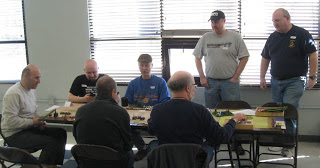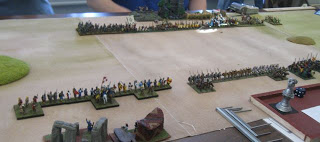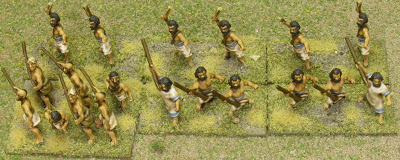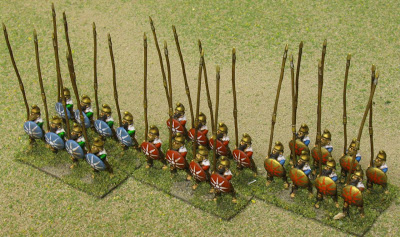Saturday was Battle at the Crossroads in Cambridge, OH. Rich, Larry, JM, and I drove out to participate in the DBA pyramid format event.
This year’s theme was Vikings and their enemies, so I brought my Leidang army. The composition I used was: 1xKn (gen), 5xBd, 1xSp, 3xAx, 2xPs.
There were several special rules in effect to keep things competitive for the Vikings. I’ll list them there for future reference, and to provide context for the tactical decisions shown in pictures below:
- Knights other than generals don’t quick kill blades
- Blades fight at +4/+3
- Viking blades receive rear support by psiloi against foot (as well as mounted)
- Vikings always attack, Leidang always defends
 |
| Larry contemplates his fate. |
I beat Larry a few weeks ago, so he wanted a grudge match. He wrote “same year as Alan” as his army’s year selection, and we were paired up in the first round. He brought East Frankish: III/52, with plenty of emasculated knights.
I had a plan for the first round, when I knew I’d be defending against a non-Viking. I set up two medium-small central woods and the required waterway. The intent of the terrain was to divide the enemy forces, while maintaining superiority in the bad going.
The biggest flaw in my plan was the possibility of a littoral landing. I hadn’t considered whether to land, or what to do with my landing force if I did. Nevertheless, I held back 2xBd and 1xPs and deployed everything else from the woods to the water.
On the first turn, I brought on my landing force somewhat forward, and angled toward the center of the board. Here, they got in my way and inhibited my movement; but, they also restricted Larry’s ability to advance effectively on that flank. They required many pips to unscrew completely, but in the mean time they weren’t a big liability: they mainly delayed any action on that side of the board.
Larry sent his horde and a spear around the other flank, and I countered with 2 Auxilia. In the end, I killed a bunch of knights on my right flank, and he killed my auxilia on my left flank. Result: 4-2, I beat Larry again. Overall, the battle was a confused mess; but I find that I often prefer a confused mess instead of two straight lines walking straight forward.
 |
| Dan Joyce’s Sub-Roman Brits; Mike Demana’s Vikings |
In the second round, we faced Dan Joyce, C-in-C playing Sub-Roman British; and Mike Demana playing Vikings. We placed woods on the sides of the board to narrow it, and a steep hill in the center. I deployed on the narrower side, and as expected, Mike’s Vikings ended up opposite me. Larry deployed against Dan’s force on the other side.
 |
| Pulling it out of the fire |
Larry made me roll his PIP die so he could blame me for the bad rolls. He got his bad rolls, and his command was the first to break. Things were looking bad, and we were about to lose. Eventually I pushed Mike’s Vikings back far enough to take the nearest camp, which happened to be the C-in-C’s camp on the wrong side of the board. The two element loss was enough to break the command, and we won.
This was an interesting, stressful game. It felt like I was running out of time, but only because I was anxious to see how things turned out in the next few turns.
 |
| The Final Round |
In the final round we played a 4-on-4 game against Scott Ludwig’s Early Germans (C-in-C), Andy Swingle’s Vikings, Rich Baier’s Leidang/Viking (I forget which), and Dave Welch’s Welsh.
 |
| Initial deployment; more Vikings are off our left flank |
We deployed on one side instead of in the center, which was a bit of a mistake, in retrospect. Mike’s Vikings were on our far left flank by the board edge. I came next, and Dan Joyce’s British were at right flank of our initial deployment.
In response, they deployed more centrally, and narrower. They ignored the vikings on our far left flank, so in order to include them in the battle we’d have to walk slowly so they could catch up. Larry, with the most mobile force, deployed on the right flank at the end of our line.
A better initial deployment might have been to deploy centrally, and place Larry’s mobile command last on whichever flank was more vulnerable. However, the enemy still would’ve been able to ignore our slower flank, so we probably wouldn’t have gained anything.
 |
| Just before we made contact |
In the early game, I wheeled to the right and Mike sent his Vikings over the hill, while the rest of our army stood still. Eventually we clashed. Dan and Larry faced 3 commands against their 2, and suffered for it. Also, Larry could have as many 1’s as he wanted on his PIP die, which I was still rolling.
 |
| Hilarity ensues; the end is almost nigh |
Larry’s command broke first, and then Dan’s. On my side of the board we had superiority, so we broke Andy’s command and then Rich’s. Neither C-in-C command was close to breaking, but we were both losing a lot of elements.
 |
| The End. This used to be straight battle lines? |
In the last few turns, we were each a few elements away from the 50% losses required to lose. Larry’s command was completely destroyed or fled off the board, and Dan was hanging on for dear life and winning some tough combats more often than statistics would suggest. It was a battle of attrition and a race to the bottom. My general ran rampant in the center of my flank, killing demoralized elements as quickly as possible to increase our death count, but Mike killed the decisive element: Andy’s blade general.
It felt like we lost this game several times, but “it’s not over until the fat Viking sings” and it was a good thing we stayed until the credits rolled.
Our side won, and I ended up taking first place for overall points, probably because of Valdemar the Victorious’ killing spree in the last game. Quick killing demoralized blades with your knight general is the kind of fun you really shouldn’t indulge in very often, or you might get spoiled.
Thanks to all of my allies and opponents for the wonderful games, and special thanks to the organizers for staging this event. I hope to be back next year!



















